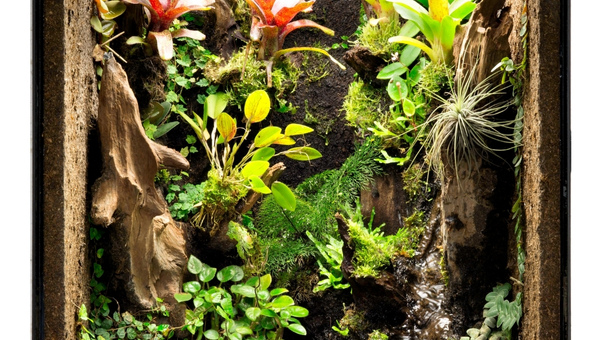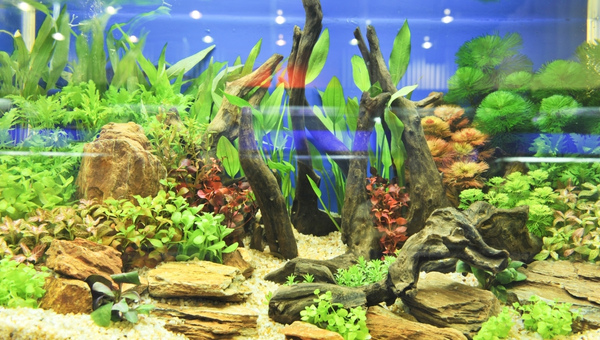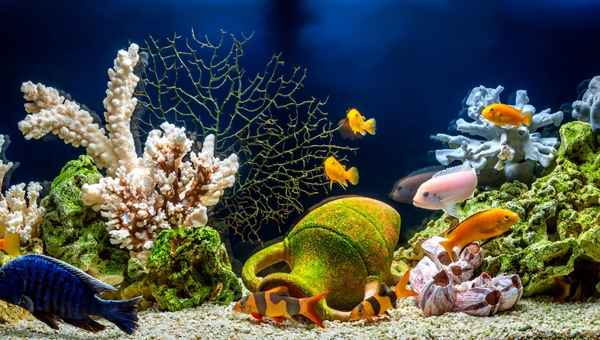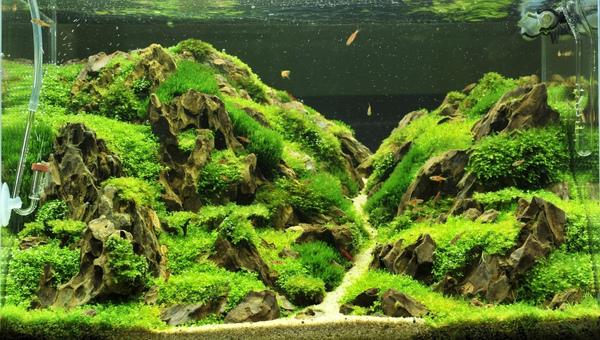Here, we will discuss building the best Paludarium tank. The word Paludarium sounds soo complicated. And to be accurate, not many people know what it is. People not interested in aquatic life and having water animals as their pets might not have even heard this word before.
Paludarium tank have recently started to gain popularity among aquarists and hobbyists. These are still not very famous. Many of you might already know what they are but are unsure of how and what you need to set them up and why you need them in the first place.
This article is for all those beginners and experienced aquarists who wish to build their Paludarium tank. We will guide you about everything necessary to build a Paludarium tank.
We will discuss all the factors you need to consider before building a Paludarium tank, who this tank is meant for, and many other exciting topics. So, please grab a drink and start reading!
Table of Contents
What Is A Paludarium
The word Paludarium is derived from two Latin words, “Plaus,” which means marsh, and “arium,” which means a place.
A Paludarium is an enclosure that recreates the natural habitat of amphibians, reptiles, and fish. It can be aesthetically pleasing and provide your pets with a comfortable home.

If you wish to understand Paludarium better, you should understand what the different, more popular tanks are, and then you will know better what a Paludarium is.
- Vivariums: A vivarium is an enclosed area that houses plants and animals. The word “vivarium” comes from the Latin word “Vivere,” which means “to live.” Vivariums can be either open or closed.
- Terrariums: A terrarium is a type of vivarium that houses plants only. The word “terrarium” comes from the Latin word “terra,” which means “land.” Terrariums can be either closed or open.
- Aquariums: An aquarium is a type of vivarium that houses fish only. The word “aquarium” comes from the Latin word “aqua,” which means “water.” Aquariums can be either freshwater or saltwater.
- Riparaium: A riparium is a type of aquarium planted on the sides of the tank. The word “riparium” comes from the Latin word “ripa,” which means “bank.” Ripariums are usually freshwater tanks.
- Paludarium: Now that you know all about the different types of vivariums, it will be easier to understand what a Paludarium is. A Paludarium can be called a terrarium which has many types of plants.
Check Otocinclus Catfish Care Guide: Appearance, Lifespan, Food & Diet, Breeding & All
Why are they gaining popularity?
Although they might look complicated to build, Paludariums are becoming increasingly popular among hobbyists for many reasons.
They are:
- Aesthetically pleasing: A Paludarium can be a beautiful addition to your home. They can be used as decoration pieces and also act as conversation starters.
- Provide a natural habitat: Paludariums provide a natural habitat for your pets. This can be beneficial for their health and well-being.
- Can be used to house many different types of animals: Paludariums can be used to house amphibians, reptiles, fish, and even mammals. This makes them a versatile option for pet owners.
Also, check Butterfly Betta Care Guide: Appearance, food & Diet, Breeding & All
What factors should you consider before building a Paludarium?
Before you start building your Paludarium, there are some factors that you need to take into consideration.
These include:
- The size of the tank will determine the type and number of animals you can keep in it. It is essential to choose a size that is appropriate for the animals you wish to keep.
- The type of animals you wish to keep: As we mentioned, Paludariums can house many animals. It is important to choose the right type of animal for your tank.
- The type of plants you wish to keep: Like animals, many different types of plants can be used in a Paludarium. It is important to choose the right type of plants for your tank.
- The type of substrate you wish to use: The type of substrate you use will determine the type of plants and animals you can keep in your tank. Choosing a substrate appropriate for the plants and animals you wish to keep is essential.
Also, check How To Cure Fish Fungus (Aquarium Fish) Ultimate Treatment & Medication
Paludarium tanks and Kit Recommendations
Now that you know everything you need to know about Paludariums, it’s time to choose the right tank and kit for your needs.
Here are our top recommendations:
- Tetra Aqua 60-Gallon Freshwater Aquarium Kit with Fish Tank, Fish Tank Filter, Heater
- Aqueon 120 Gallon Glass Aquarium Tank
- Marineland ML90609 Portrait Glass LED Aquarium Kit, 5-Gallon
- Aqueon 100527678 Standard Glass Rectangle Aquarium Tank, Black, 10 Gallon
- Fluval Flex 15-gallon Saltwater Kit
- Zoo Med ReptiBreeze Open Air Screen Cage
- Tetra Crystal Water 10 Gallon Aquarium Kit
- Exo Terra PT2602 Large Glass Terrarium, 24 by 18 by 36-Inch
- Marineland ML90670PEN Peninsula Glass Aquarium Kit, 20L (5.3 GAL)
As you can see, many Paludarium tanks and kits are available. It is important to choose the right one for your needs.
You may also check Tomini Tang Fish Care Guide: Appearance, Breeding & All
Potential Animals To Include In Your Paludarium
Paludariums have a semi-aquatic environment. These can be home to many species of terrestrial and aquatic animals. They can also be a habitat for many types of plants.

You can add some species to your Paludarium to improve your tank’s environment.
Freshwater Fish
Many types of freshwater fish can be added to your Paludarium. These include goldfish, guppies, tetras, mollies, killifish, angelfish, gouramis, and danios. Some people add only a few fish. This helps to make the tank look neat and subtle.

You should remember that when you select more than one fish, the requirements of each fish must be similar.
Shrimps and Crabs
These animals can help keep the aquarium clean and provide food for other animals in the tank. They will eat all the debris and little waste from your tank.
They are often called the cleaning crew of any tank. Species like cherry shrimp, Amano shrimp, Ghost shrimp, etc., can make your tank look prettier.
Snails and Other Semi-Aquatic Options
Some popular snails you can add to your Paludarium are the mystery, Apple, and Nerite snail. They will help keep your tank clean and add color to it.
Semi-aquatic options include:
- Turtle: These are exciting animals to look at and are known to live for a long time. A painted slider is a good option to consider.
- Frogs: They have an amphibian lifestyle and can be a great addition to your Paludarium. Green and Dart frogs make a good choice. You might also add some tadpoles to your tank. This can facilitate their growth.
- Newts: These can be added to your Paludarium to create a naturalistic environment. These are very active beings often seen diving in the water or walking on the land. Fire-bellied and Pacific newts are good choices.
- Lizard: They are known to be good swimmers and can be a great addition to your tank.
- Salamanders: These are good swimmers and can add variety to your Paludarium. The tiger salamander is our favorite.
The most crucial thing you must remember is that you should only add species that will not be proven toxic when ingested by others.

It would help to remember that not every species will easily co-exist in the same habitat. You should add species after knowing they will live harmoniously with your mates. This will reduce the chance of any unfortunate conflicts and casualties.
Like any other tank, you should also know that a Paludarium’s water should be cycled regularly before the animals are placed. There should be partial water changes done to maintain a healthy environment.
Also, Check Bellus Angelfish Care: Appearance, Size, Lifespan, Diet & All
Which Plants To Include?
There are many types of plants that you can include in your Paludarium.
Here are some of the most popular ones:
- Mosses: They absorb a lot of water and help keep the humidity in the air high. This makes them an excellent addition to your Paludarium.
- Ferns: These plants can help create a natural environment in your tank.
- Ivy: They can help to create a dense and lush environment in your Paludarium.
- Creeping Jenny: These plants have beautiful leaves and can add color to your tank.
- Anubias: Are hardy plants that can survive in aquatic and terrestrial conditions.
- Swords: These are also known to be hardy plants and can add some height to your Paludarium.
- Cryptocoryne: These beautiful plants can add color to your tank.
It would be best to remember to include a mix of aquatic and terrestrial plants in your Paludarium. This will help to create a more naturalistic environment for your animals.
Check Sand Sifting Starfish 101: Care, Appearance, Lifespan, Diet & All
Building And Setup Process
Now that you know which animals and plants to include, it’s time to start building your Paludarium. If you are a beginner, we suggest starting with a tank of 5 gallons and slowly working your way up with time. You can follow the steps mentioned and described below to set up your Paludarium.
Planning The Layout
The first thing that you need to do is to plan the layout of your Paludarium. It would help to decide where you want to place the land and water areas.
You can use a sheet of paper and draw out the layout of your Paludarium. This will help you visualize the final product and make necessary changes.
You may also check Pipefish 101:Care, Appearance, Diet, Breeding, Lifespan & All
Adding The Land Area
Once you have planned the layout, it’s time to add the land area. You can use a variety of materials to create the land area. The most popular ones include wood, sand, rock, etc. You can also use bowls and other safe items to add height to your Paludarium.
Before adding anything else, consider what might be difficult to remove and clean. You can use foam sealant to hold things together. The land portion should also have a proper drainage system.
You may also check Vampire Crab Ultimate Care Guide: Appearance, Food & Diet, Breeding, Lifespan & All
Adding The Water Area
Once you have added the land area, it’s time to add the water area. You can use a variety of materials to create the water area.
Some of the most popular ones include:
- Rocks: You can use rocks to create the water area. This is a natural option and will help to create a more realistic environment.
- Plastic Tubing: This is a popular choice as it is lightweight and easy to work with.
You should remember to add a layer of gravel on top of the rocks or plastic tubing. This will help to keep the material in place and prevent it from floating when the water is added.
Check Bamboo Shrimp Care Guide, Appearance, Size, Diet, & All
Adding The Substrate
Once you have added the plants, it’s time to add the substrate. This material will help keep the plants in place and give them the nutrients they need to grow.
Some of the most popular substrates include:
- Soil: This is the most natural option and will help to provide the plants with the nutrients they need to grow.
- Coconut Husk: This is a popular choice as it is natural and helps to create a humid environment.
- Expanded Clay Pellets: These are also popular as they are lightweight and help with drainage.
You should remember to add a layer of gravel on top of the substrate. This will help to keep the material in place and prevent it from floating when the water is added.
Adding The Plants
Now that you have added the land and water areas, it’s time to add the plants. You can use a variety of plants to create a naturalistic environment. You can choose from the options we mentioned earlier.
Also, check Ember Tetra Care Guide: Size, Diet, Tankmates, Lifespan & All
Area Connecting Land And Water
The area connecting the land and water is known as the beach. This is a crucial part of the Paludarium as it provides a transition between the two areas.
You can use a variety of materials to create the beach. Some of the most popular ones are sand, cork, and floating shelves covered with moss, peat, driftwood, or PVC.
Waterfall Setup (Optional)
You can also add a waterfall to your Paludarium. This is an optional feature, but it will definitely make your Paludarium stand out. You can use a variety of materials to create the waterfall. Some of the most popular ones are rocks, plastic tubing, and even glass.
Remember to add a layer of gravel on top of the rocks or plastic tubing. This will help to keep the material in place and prevent it from floating when the water is added.
Check Frogspawn Coral 101: Size, Feeding, Breeding, Care Guide
Filtration System
Lastly, you need to add a filtration system to your Paludarium. This is a crucial part of the setup as it helps keep the water clean and toxins-free. There are a variety of filtration systems available on the market. You can choose from internal or external filter systems.
You may also check Bristlenose Pleco Care Guide: Lifespan, Diet, Size & All
Wrapping It Up
Paludariums can be a great addition to any home and can provide you with hours of enjoyment. With a little planning and effort, you can create a beautiful and natural environment for your animals. For this reason, they are becoming increasingly popular among pet owners.
We hope that you finally understand what Paludariums are all about. We expect you to do more research if you are interested in building your Paludarium.
Make sure that you have all the resources and all the things you need beforehand to avoid any hassle. Thank you so much for reading, and start creating your perfect Paludarium.
